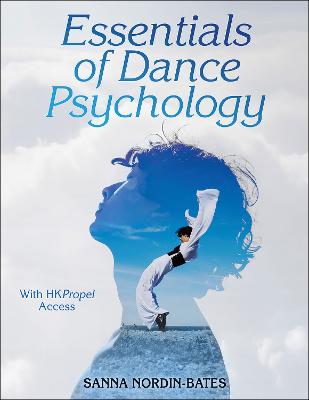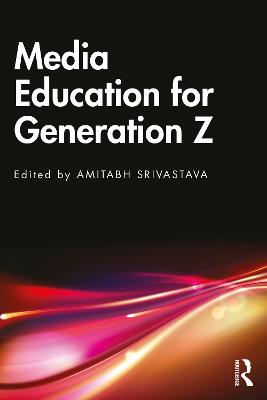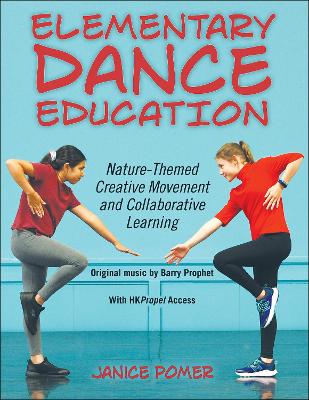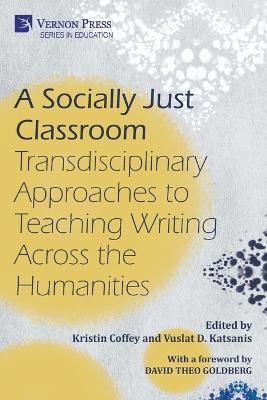Essentials of Dance Psychology
 portes grátis
portes grátis
Essentials of Dance Psychology
Nordin-Bates, Sanna
Human Kinetics Publishers
10/2022
352
Mole
Inglês
9781718207554
15 a 20 dias
1043
Descrição não disponível.
Introduction to Dance Psychology
What Is Dance Psychology?
Cognitive Behavioral Therapy in Dance Psychology
Part I. Individual Differences
Chapter 1. Personality
What Is Personality?
Structure of Personality
Origins of Personality
Consequences of Personality
Narrow Identity: Are Dancers at Risk?
Chapter 2. Perfectionism
What Is Perfectionism?
Origins of Perfectionism in Dance
Consequences of Perfectionism
How Can Perfectionism Be Managed?
Chapter 3. Self-Esteem and Self-Confidence
What Are Self-Esteem and Self-Confidence?
Origins of Self-Esteem
Consequences of Self-Esteem
Origins of Self-Confidence
Consequences of Self-Confidence
How Can Self-Esteem and Self-Confidence Be Strengthened?
Chapter 4. Anxiety
What Is Anxiety?
Sources of Anxiety
Consequences of Anxiety
How Can Anxiety Be Managed?
Part II. Dance-Specific Characteristics and Dispositions
Chapter 5. Motivation
What Is Motivation?
Achievement Goal Theory Perspective on Motivation
Self-Determination Theory Perspective on Motivation
How Can Healthy Motivation Be Nurtured? An Intrapersonal Perspective
Chapter 6. Attentional Focus
What Is Attentional Focus?
Performance-Related Consequences of Different Attentional Foci
Attentional Focus Research in Dance
Why Attentional Focus Has an Impact
How Can Optimal Attentional Focus Be Nurtured?
Chapter 7. Creativity
What Is Creativity?
Sources of Creativity
Correlates of Creativity
How Can Creativity Be Nurtured?
Part III. Psychological Skills
Chapter 8. Mindfulness
What Is Mindfulness?
Origins of Mindfulness
Consequences of Mindfulness
Mindfulness Research in Dance
Why Mindfulness Has an Impact
How Can Mindfulness Be Nurtured?
Chapter 9. Goal Setting and Self-Regulation
What Is Goal Setting?
Sources of Goals: Assigned Goals Versus Personal Values
Consequences of Goal Setting
Why Goal Setting Has an Impact
What Is Self-Regulation?
How Can Goal Setting and Self-Regulation Be Optimized?
Chapter 10. Imagery
What Is Imagery?
Revised Applied Model of Deliberate Imagery Use
Sources of Imagery
Consequences of Imagery
Why Imagery Has an Impact
How Can Imagery Be Optimized?
Part IV. Dance Environments and Challenges
Chapter 11. Motivational Climates
What Is a Motivational Climate?
Achievement Goal Theory (AGT) Perspective: Task- and Ego-Involving Climates
Self-Determination Theory Perspective: Need-Supportive Versus Controlling Leadership
Origins of Motivational Climates: What Makes Teachers Support or Thwart Healthy Motivation?
Consequences of Motivational Climates
How Are Healthy Motivational Climates Created?
Chapter 12. Talent
What Is Talent?
Sources of Talent
Consequences of Talent Beliefs and of Talent Identification
How Can Talent Identification and Development Be Optimized?
Chapter 13. Injury
What Are the Key Psychological Aspects of Injury in Dance?
Psychological Risk Factors for Acute Injury: Stress-Injury Model
Beyond the Stress-Injury Model: Other Psychological Risk Factors for Dance Injury
Dancers' Experiences of Becoming and of Being Injured
Psychological Aspects of Injury Rehabilitation
Using Psychology to Reduce Injury Risk and Optimize Rehabilitation
Chapter 14. Body Image and Disordered Eating
What Is Body Image?
Eating Disorders Versus Disordered Eating
Origins of Negative Body Image and Disordered Eating in Dance
Consequences of Body Image and Disordered Eating
How Can Healthy Body Image Be Nurtured?
How Can Disordered Eating Be Prevented, Identified, and Managed?
What Is Dance Psychology?
Cognitive Behavioral Therapy in Dance Psychology
Part I. Individual Differences
Chapter 1. Personality
What Is Personality?
Structure of Personality
Origins of Personality
Consequences of Personality
Narrow Identity: Are Dancers at Risk?
Chapter 2. Perfectionism
What Is Perfectionism?
Origins of Perfectionism in Dance
Consequences of Perfectionism
How Can Perfectionism Be Managed?
Chapter 3. Self-Esteem and Self-Confidence
What Are Self-Esteem and Self-Confidence?
Origins of Self-Esteem
Consequences of Self-Esteem
Origins of Self-Confidence
Consequences of Self-Confidence
How Can Self-Esteem and Self-Confidence Be Strengthened?
Chapter 4. Anxiety
What Is Anxiety?
Sources of Anxiety
Consequences of Anxiety
How Can Anxiety Be Managed?
Part II. Dance-Specific Characteristics and Dispositions
Chapter 5. Motivation
What Is Motivation?
Achievement Goal Theory Perspective on Motivation
Self-Determination Theory Perspective on Motivation
How Can Healthy Motivation Be Nurtured? An Intrapersonal Perspective
Chapter 6. Attentional Focus
What Is Attentional Focus?
Performance-Related Consequences of Different Attentional Foci
Attentional Focus Research in Dance
Why Attentional Focus Has an Impact
How Can Optimal Attentional Focus Be Nurtured?
Chapter 7. Creativity
What Is Creativity?
Sources of Creativity
Correlates of Creativity
How Can Creativity Be Nurtured?
Part III. Psychological Skills
Chapter 8. Mindfulness
What Is Mindfulness?
Origins of Mindfulness
Consequences of Mindfulness
Mindfulness Research in Dance
Why Mindfulness Has an Impact
How Can Mindfulness Be Nurtured?
Chapter 9. Goal Setting and Self-Regulation
What Is Goal Setting?
Sources of Goals: Assigned Goals Versus Personal Values
Consequences of Goal Setting
Why Goal Setting Has an Impact
What Is Self-Regulation?
How Can Goal Setting and Self-Regulation Be Optimized?
Chapter 10. Imagery
What Is Imagery?
Revised Applied Model of Deliberate Imagery Use
Sources of Imagery
Consequences of Imagery
Why Imagery Has an Impact
How Can Imagery Be Optimized?
Part IV. Dance Environments and Challenges
Chapter 11. Motivational Climates
What Is a Motivational Climate?
Achievement Goal Theory (AGT) Perspective: Task- and Ego-Involving Climates
Self-Determination Theory Perspective: Need-Supportive Versus Controlling Leadership
Origins of Motivational Climates: What Makes Teachers Support or Thwart Healthy Motivation?
Consequences of Motivational Climates
How Are Healthy Motivational Climates Created?
Chapter 12. Talent
What Is Talent?
Sources of Talent
Consequences of Talent Beliefs and of Talent Identification
How Can Talent Identification and Development Be Optimized?
Chapter 13. Injury
What Are the Key Psychological Aspects of Injury in Dance?
Psychological Risk Factors for Acute Injury: Stress-Injury Model
Beyond the Stress-Injury Model: Other Psychological Risk Factors for Dance Injury
Dancers' Experiences of Becoming and of Being Injured
Psychological Aspects of Injury Rehabilitation
Using Psychology to Reduce Injury Risk and Optimize Rehabilitation
Chapter 14. Body Image and Disordered Eating
What Is Body Image?
Eating Disorders Versus Disordered Eating
Origins of Negative Body Image and Disordered Eating in Dance
Consequences of Body Image and Disordered Eating
How Can Healthy Body Image Be Nurtured?
How Can Disordered Eating Be Prevented, Identified, and Managed?
Este título pertence ao(s) assunto(s) indicados(s). Para ver outros títulos clique no assunto desejado.
Dance psychology; dance pedagogy; dance science; dance education; dance teacher; dance educator; dance textbook; introduction to dance; dance performance; dance teaching methods
Introduction to Dance Psychology
What Is Dance Psychology?
Cognitive Behavioral Therapy in Dance Psychology
Part I. Individual Differences
Chapter 1. Personality
What Is Personality?
Structure of Personality
Origins of Personality
Consequences of Personality
Narrow Identity: Are Dancers at Risk?
Chapter 2. Perfectionism
What Is Perfectionism?
Origins of Perfectionism in Dance
Consequences of Perfectionism
How Can Perfectionism Be Managed?
Chapter 3. Self-Esteem and Self-Confidence
What Are Self-Esteem and Self-Confidence?
Origins of Self-Esteem
Consequences of Self-Esteem
Origins of Self-Confidence
Consequences of Self-Confidence
How Can Self-Esteem and Self-Confidence Be Strengthened?
Chapter 4. Anxiety
What Is Anxiety?
Sources of Anxiety
Consequences of Anxiety
How Can Anxiety Be Managed?
Part II. Dance-Specific Characteristics and Dispositions
Chapter 5. Motivation
What Is Motivation?
Achievement Goal Theory Perspective on Motivation
Self-Determination Theory Perspective on Motivation
How Can Healthy Motivation Be Nurtured? An Intrapersonal Perspective
Chapter 6. Attentional Focus
What Is Attentional Focus?
Performance-Related Consequences of Different Attentional Foci
Attentional Focus Research in Dance
Why Attentional Focus Has an Impact
How Can Optimal Attentional Focus Be Nurtured?
Chapter 7. Creativity
What Is Creativity?
Sources of Creativity
Correlates of Creativity
How Can Creativity Be Nurtured?
Part III. Psychological Skills
Chapter 8. Mindfulness
What Is Mindfulness?
Origins of Mindfulness
Consequences of Mindfulness
Mindfulness Research in Dance
Why Mindfulness Has an Impact
How Can Mindfulness Be Nurtured?
Chapter 9. Goal Setting and Self-Regulation
What Is Goal Setting?
Sources of Goals: Assigned Goals Versus Personal Values
Consequences of Goal Setting
Why Goal Setting Has an Impact
What Is Self-Regulation?
How Can Goal Setting and Self-Regulation Be Optimized?
Chapter 10. Imagery
What Is Imagery?
Revised Applied Model of Deliberate Imagery Use
Sources of Imagery
Consequences of Imagery
Why Imagery Has an Impact
How Can Imagery Be Optimized?
Part IV. Dance Environments and Challenges
Chapter 11. Motivational Climates
What Is a Motivational Climate?
Achievement Goal Theory (AGT) Perspective: Task- and Ego-Involving Climates
Self-Determination Theory Perspective: Need-Supportive Versus Controlling Leadership
Origins of Motivational Climates: What Makes Teachers Support or Thwart Healthy Motivation?
Consequences of Motivational Climates
How Are Healthy Motivational Climates Created?
Chapter 12. Talent
What Is Talent?
Sources of Talent
Consequences of Talent Beliefs and of Talent Identification
How Can Talent Identification and Development Be Optimized?
Chapter 13. Injury
What Are the Key Psychological Aspects of Injury in Dance?
Psychological Risk Factors for Acute Injury: Stress-Injury Model
Beyond the Stress-Injury Model: Other Psychological Risk Factors for Dance Injury
Dancers' Experiences of Becoming and of Being Injured
Psychological Aspects of Injury Rehabilitation
Using Psychology to Reduce Injury Risk and Optimize Rehabilitation
Chapter 14. Body Image and Disordered Eating
What Is Body Image?
Eating Disorders Versus Disordered Eating
Origins of Negative Body Image and Disordered Eating in Dance
Consequences of Body Image and Disordered Eating
How Can Healthy Body Image Be Nurtured?
How Can Disordered Eating Be Prevented, Identified, and Managed?
What Is Dance Psychology?
Cognitive Behavioral Therapy in Dance Psychology
Part I. Individual Differences
Chapter 1. Personality
What Is Personality?
Structure of Personality
Origins of Personality
Consequences of Personality
Narrow Identity: Are Dancers at Risk?
Chapter 2. Perfectionism
What Is Perfectionism?
Origins of Perfectionism in Dance
Consequences of Perfectionism
How Can Perfectionism Be Managed?
Chapter 3. Self-Esteem and Self-Confidence
What Are Self-Esteem and Self-Confidence?
Origins of Self-Esteem
Consequences of Self-Esteem
Origins of Self-Confidence
Consequences of Self-Confidence
How Can Self-Esteem and Self-Confidence Be Strengthened?
Chapter 4. Anxiety
What Is Anxiety?
Sources of Anxiety
Consequences of Anxiety
How Can Anxiety Be Managed?
Part II. Dance-Specific Characteristics and Dispositions
Chapter 5. Motivation
What Is Motivation?
Achievement Goal Theory Perspective on Motivation
Self-Determination Theory Perspective on Motivation
How Can Healthy Motivation Be Nurtured? An Intrapersonal Perspective
Chapter 6. Attentional Focus
What Is Attentional Focus?
Performance-Related Consequences of Different Attentional Foci
Attentional Focus Research in Dance
Why Attentional Focus Has an Impact
How Can Optimal Attentional Focus Be Nurtured?
Chapter 7. Creativity
What Is Creativity?
Sources of Creativity
Correlates of Creativity
How Can Creativity Be Nurtured?
Part III. Psychological Skills
Chapter 8. Mindfulness
What Is Mindfulness?
Origins of Mindfulness
Consequences of Mindfulness
Mindfulness Research in Dance
Why Mindfulness Has an Impact
How Can Mindfulness Be Nurtured?
Chapter 9. Goal Setting and Self-Regulation
What Is Goal Setting?
Sources of Goals: Assigned Goals Versus Personal Values
Consequences of Goal Setting
Why Goal Setting Has an Impact
What Is Self-Regulation?
How Can Goal Setting and Self-Regulation Be Optimized?
Chapter 10. Imagery
What Is Imagery?
Revised Applied Model of Deliberate Imagery Use
Sources of Imagery
Consequences of Imagery
Why Imagery Has an Impact
How Can Imagery Be Optimized?
Part IV. Dance Environments and Challenges
Chapter 11. Motivational Climates
What Is a Motivational Climate?
Achievement Goal Theory (AGT) Perspective: Task- and Ego-Involving Climates
Self-Determination Theory Perspective: Need-Supportive Versus Controlling Leadership
Origins of Motivational Climates: What Makes Teachers Support or Thwart Healthy Motivation?
Consequences of Motivational Climates
How Are Healthy Motivational Climates Created?
Chapter 12. Talent
What Is Talent?
Sources of Talent
Consequences of Talent Beliefs and of Talent Identification
How Can Talent Identification and Development Be Optimized?
Chapter 13. Injury
What Are the Key Psychological Aspects of Injury in Dance?
Psychological Risk Factors for Acute Injury: Stress-Injury Model
Beyond the Stress-Injury Model: Other Psychological Risk Factors for Dance Injury
Dancers' Experiences of Becoming and of Being Injured
Psychological Aspects of Injury Rehabilitation
Using Psychology to Reduce Injury Risk and Optimize Rehabilitation
Chapter 14. Body Image and Disordered Eating
What Is Body Image?
Eating Disorders Versus Disordered Eating
Origins of Negative Body Image and Disordered Eating in Dance
Consequences of Body Image and Disordered Eating
How Can Healthy Body Image Be Nurtured?
How Can Disordered Eating Be Prevented, Identified, and Managed?
Este título pertence ao(s) assunto(s) indicados(s). Para ver outros títulos clique no assunto desejado.







